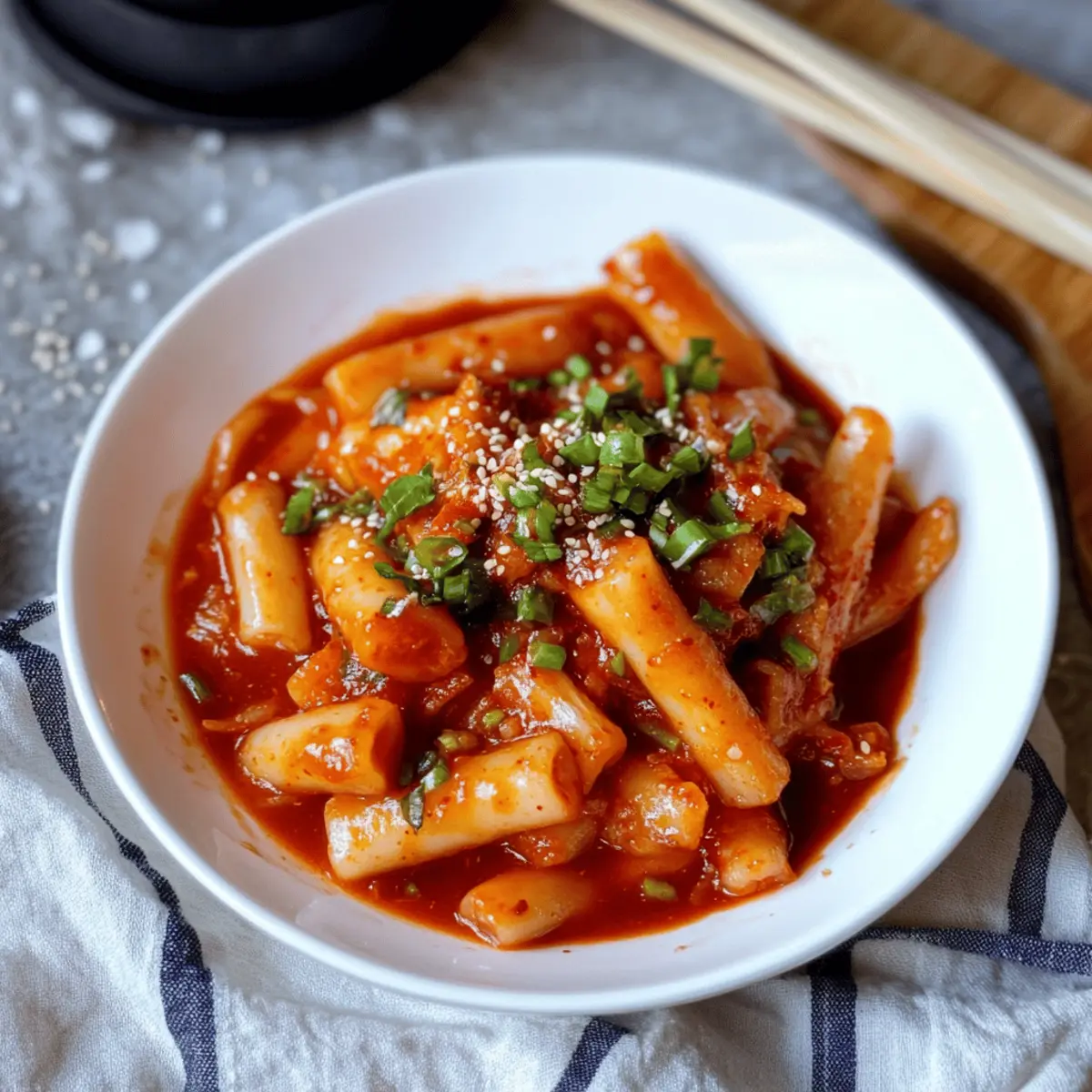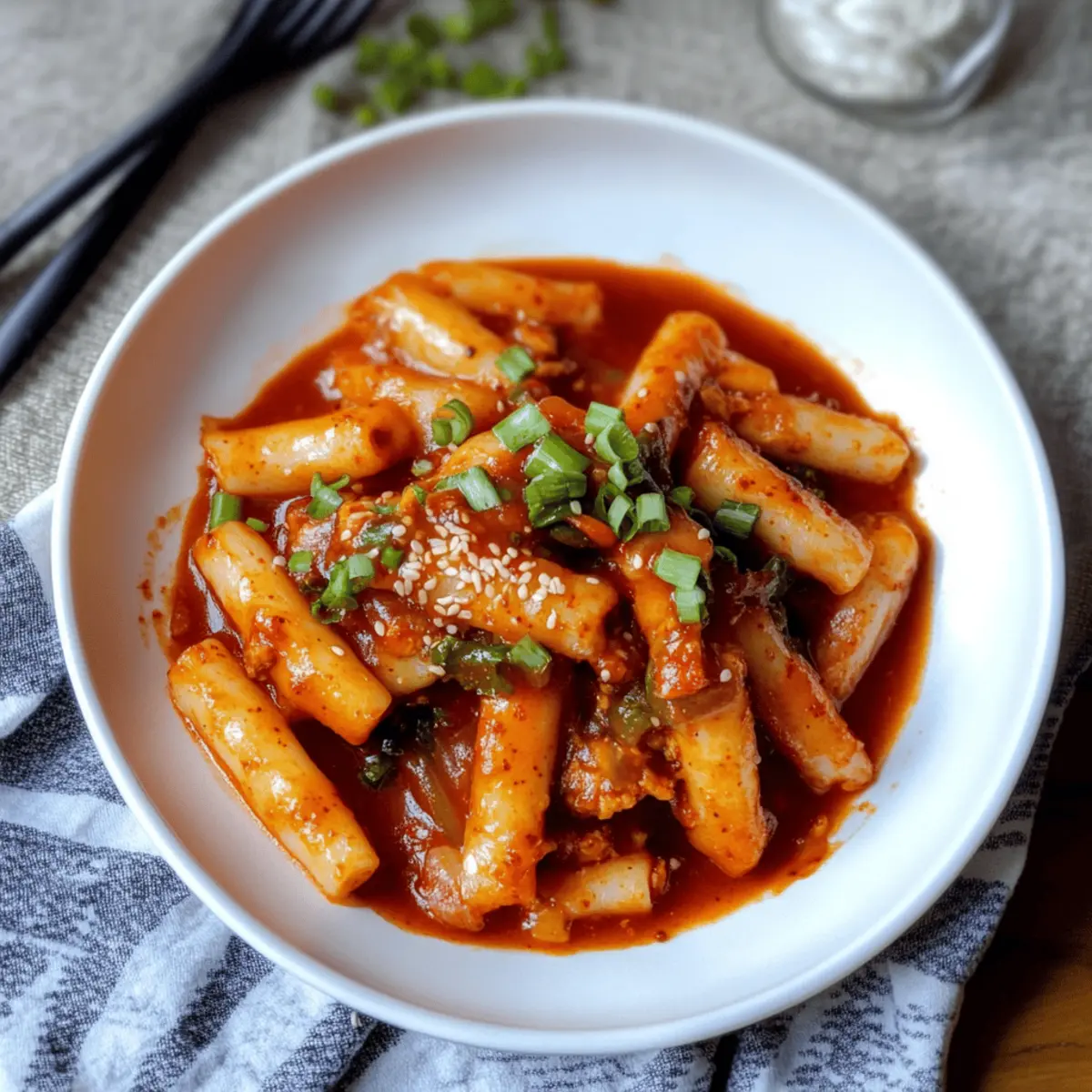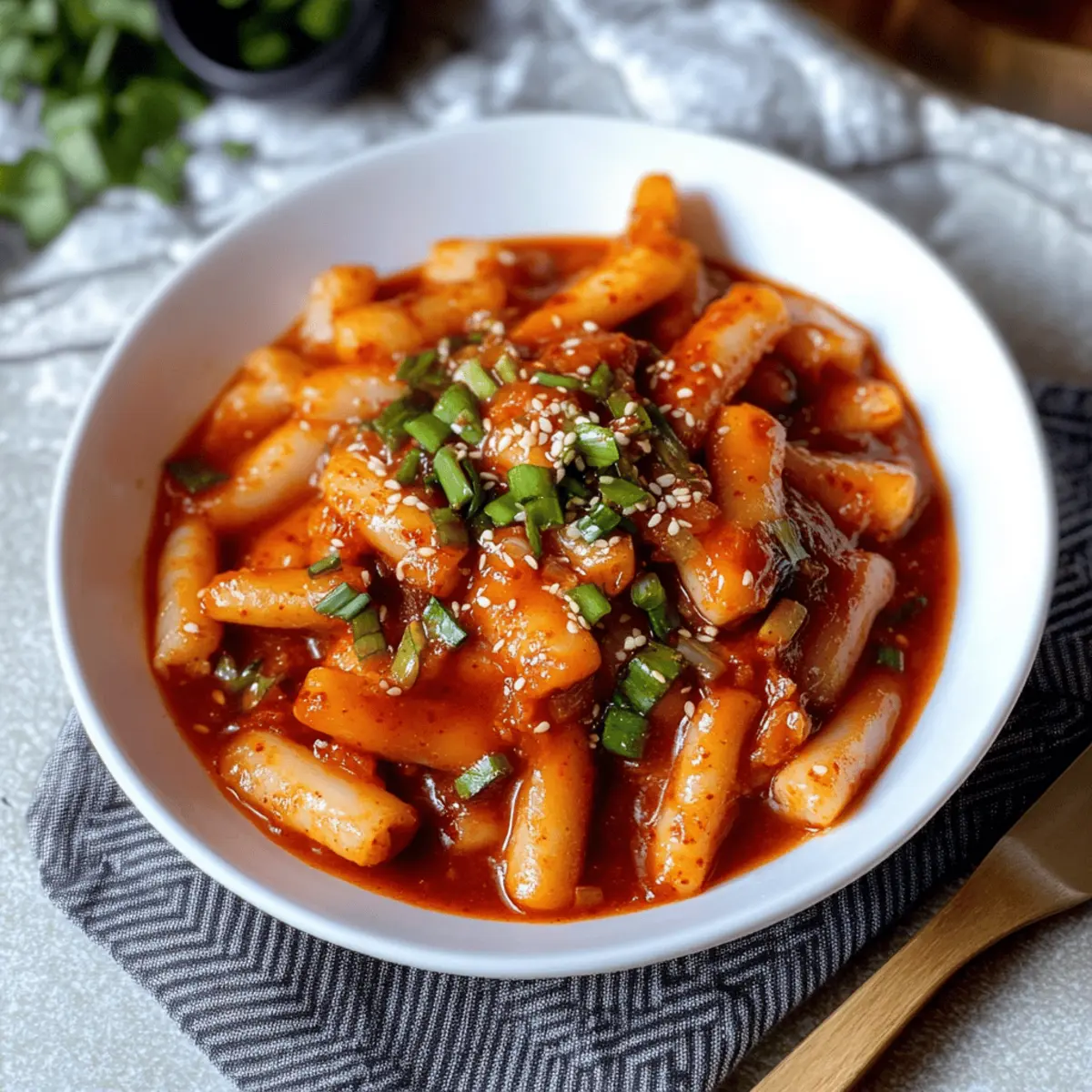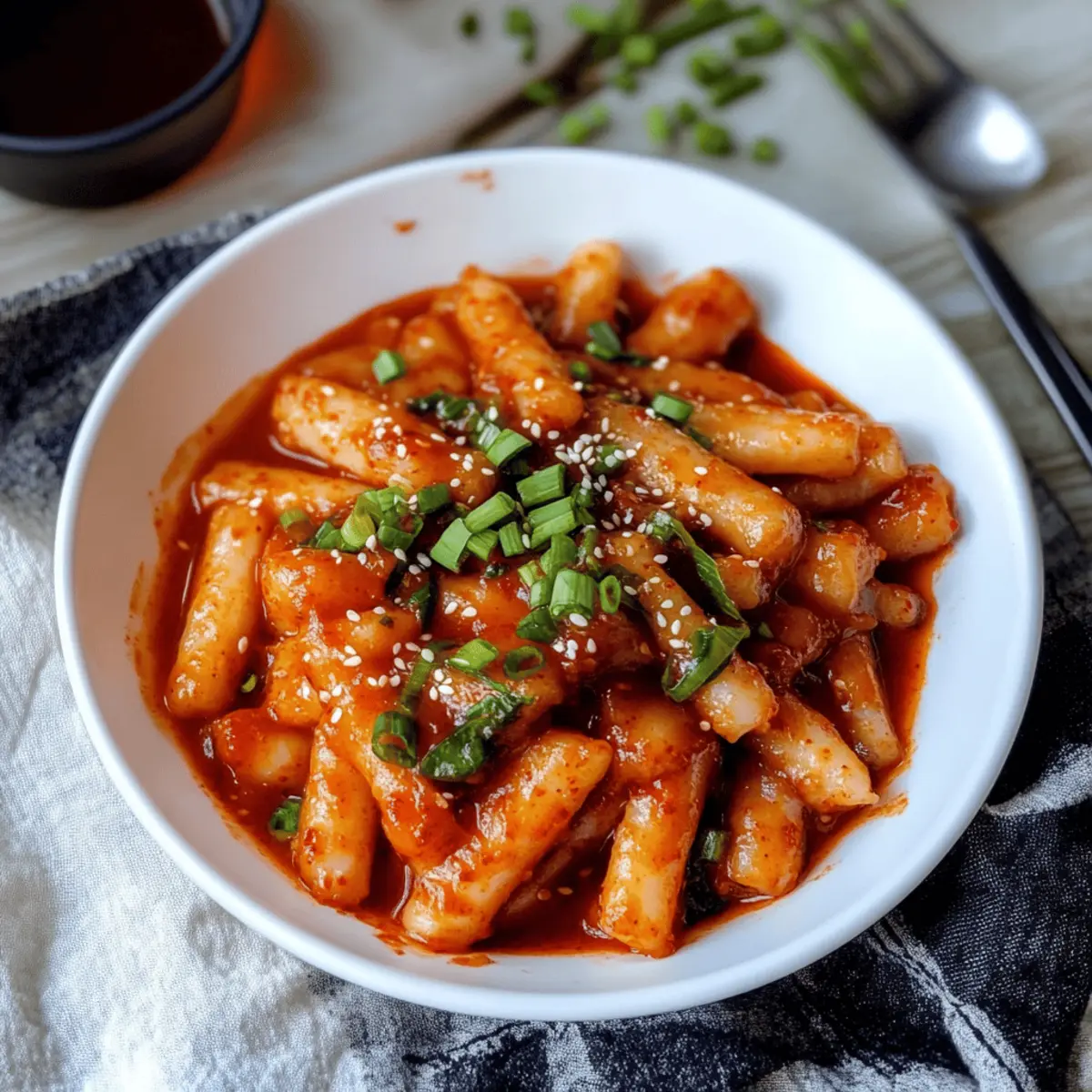As the spicy aroma of Gochujang begins to swirl in the air, I can’t help but feel a rush of excitement—it’s Tteokbokki time! This beloved Korean street food is the ultimate comfort dish, combining sweet, spicy, and nutty flavors in a mesmerizing 35-minute recipe. Picture sitting down with a plate of chewy rice cakes, all lovingly coated in a fiery sauce that promises to awaken your taste buds and warm your soul. Whether you’re craving a cozy night in or looking to impress friends with restaurant-quality tastes, this classic Tteokbokki (Dukbokki) recipe is a game-changer. Plus, there’s room for everyone at the table with its easy vegan adaptation! Curious how to make this delightful dish at home? Let’s dive in!

Why is Tteokbokki So Irresistible?
Comforting, Chewy Texture: Tteokbokki features delightful rice cakes that offer an addictive chewiness, making each bite a joy.
Fiery Flavor Boost: The combination of gochujang and gochugaru creates a perfectly spicy sauce that tantalizes the palate.
Quick and Simple: With just 35 minutes from start to finish, you can whip up an impressive dish that’s ready to serve.
Versatile for All: This recipe accommodates dietary preferences with vegan options, so everyone can indulge in deliciousness without compromise.
Crowd-Pleasing Delight: Serve it at gatherings, and watch your friends come back for seconds on this unforgettable street food favorite! Looking for more comfort food ideas? Check out our ultimate guide to Korean cuisine.
Tteokbokki Ingredients
For the Sauce
- Anchovy stock or water – This forms the flavorful base for your sauce; use vegetable broth for a vegan twist.
- Dried kelp – Essential for adding umami to the broth; just remember to remove it after simmering!
- Gochujang (Korean red chili paste) – The heart of Tteokbokki’s flavor; it’s a must for that authentic spicy kick.
- Gochugaru (Korean chili pepper flakes) – These flakes add vibrant color and heat; sprinkle to adjust the spice level.
- Soy sauce – Boosts the umami flavor; use gluten-free soy sauce if needed for dietary considerations.
- Sugar – Balances out the heat from the gochujang; don’t skip this for a well-rounded flavor.
For the Rice Cakes
- Tteokbokki (Korean rice cakes) – These chewy rice cakes are the star of the dish; both frozen and fresh work wonderfully.
- Korean fish cakes – Adds a tasty protein element; swap out for fried tofu to keep it vegan.
Finishing Touches
- Toasted sesame oil – This fragrant oil gives a nutty depth; it’s a non-negotiable for flavor.
- Scallions – For a fresh burst of color and taste; chives can be a great substitute.
- Sesame seeds – For that delightful crunch and final garnish; optional, but highly recommended for serving.
Now that you have all the vibrant ingredients ready, let’s get cooking and bring the magic of Tteokbokki right to your kitchen!
Step‑by‑Step Instructions for Tteokbokki (Dukbokki)
Step 1: Make the Broth
In a medium pot, combine 4 cups of anchovy stock (or water) and a piece of dried kelp. Bring the mixture to a rolling boil over high heat, then reduce to a simmer. Allow it to simmer for about 10 minutes, then carefully remove the kelp, discarding it, to retain its rich umami flavor in the broth.
Step 2: Season the Broth
Return the pot to medium heat and stir in 3 tablespoons of gochujang, 1 tablespoon of gochugaru, 2 tablespoons of soy sauce, and 1 tablespoon of sugar. Allow this mixture to come back to a boil, watching as the colors intensify and the aroma fills your kitchen. This flavorful base is essential for your Tteokbokki (Dukbokki).
Step 3: Cook the Rice Cakes
Once boiling, add 14 ounces of tteokbokki (Korean rice cakes) to the pot, stirring to coat them evenly in the spicy sauce. Cook for 8-10 minutes, stirring occasionally until the rice cakes soften and become chewy, soaking up the vibrant flavors of the sauce. The cakes should be tender but not falling apart.
Step 4: Add the Fish Cakes
Next, mix in 8 ounces of Korean fish cakes, continuing to stir gently. Cook for an additional 4 minutes, allowing the fish cakes to warm through and soak up the flavors from the sauce. This step not only adds protein to your dish but also enhances the overall texture of the Tteokbokki.
Step 5: Serve
After all ingredients are well-combined and heated through, turn off the heat. Stir in 1 tablespoon of toasted sesame oil for a final touch of nuttiness and garnish with chopped scallions. Carefully transfer the delicious Tteokbokki to a serving bowl and sprinkle with sesame seeds if desired. Enjoy your homemade delight!

Expert Tips for Tteokbokki (Dukbokki)
-
Fresh Ingredients Matter: Use fresh tteokbokki rice cakes for the best texture and flavor; frozen ones can still work, but fresh offers a chewier bite.
-
Balance the Spice: If you’re sensitive to heat, start with less gochugaru and add gradually; you can always spice it up later!
-
Stir Often: To prevent the rice cakes from sticking to the pot, stir them frequently while cooking; this keeps that delightful, chewy texture intact.
-
Embrace Variations: Don’t hesitate to customize your Tteokbokki by adding vegetables like bok choy or carrots for extra nutrients and flavors.
-
Serve Immediately: Tteokbokki is best enjoyed fresh off the stove, as it tends to harden as it cools; serve immediately for the perfect taste experience!
How to Store and Freeze Tteokbokki
Room Temperature: Tteokbokki is best enjoyed fresh, but if left out, consume within 2 hours to avoid spoilage.
Fridge: Store leftovers in an airtight container for up to 3 days. When you’re ready to enjoy again, reheat with a splash of water to loosen the sauce and soften the rice cakes.
Freezer: Tteokbokki can be frozen, though the texture may change. To freeze, place in a freezer-safe container for up to 2 months. Thaw in the fridge overnight before reheating.
Reheating: For the best results, reheat on the stovetop over low heat, adding a bit of water to revive the sauce and rice cakes. Avoid microwaving to maintain texture.
Tteokbokki Variations & Substitutions
Feel free to put your own spin on this dish—let your creativity shine as you mix flavors and textures!
-
Vegan Option: Substitute fish cakes with fried tofu to create a completely plant-based version while still enjoying the chewy goodness.
-
Gluten-Free: Use gluten-free soy sauce in place of regular soy sauce for those with gluten sensitivities, keeping the flavor intact.
-
Extra Veggies: Add in colorful vegetables like bell peppers, carrots, or bok choy for a nutritious twist that enhances both flavor and texture.
-
Spicy Kick: Craving more heat? Toss in some sliced fresh chili peppers or increase the gochugaru for a fiery adventure.
-
Sweet Twist: For a unique flavor, consider adding a touch of honey or maple syrup instead of granulated sugar to create a delightful balance with the heat.
-
Nutty Flavor: Enhance the dish’s aroma by stirring in a tablespoon of peanut butter or tahini for a rich, nutty depth that will surprise your taste buds!
-
Creamy Addition: If you’re feeling adventurous, mix in a splash of coconut milk at the end to add a creamy texture, transforming your Tteokbokki into a luscious delight.
-
Serving Style: Serve with a side of pickled radish or kimchi for a refreshing balance to the spicy Tteokbokki, bringing the flavors of Korean cuisine to your table!
Looking for more inspiration? Check out our cozy ultimate guide to Korean cuisine for additional delicious dishes to try!
What to Serve with Spicy Tteokbokki (Dukbokki)?
Delightful aromas and vibrant colors set the stage for a memorable meal experience, and Tteokbokki pairs beautifully with a variety of dishes.
-
Light Kimchi: The tangy crunch of kimchi cuts through the richness of the Tteokbokki, offering a refreshing contrast that enhances each bite.
-
Refreshing Cucumber Salad: A cool cucumber salad adds a crunchy texture and a burst of freshness, balancing the fiery flavors of the rice cakes.
-
Savory Korean Pancakes: These delightful pancakes, filled with vegetables or seafood, complement the chewy Tteokbokki with their crispy edges and soft interiors.
-
Steamed Banchan: Pair with simple banchan like steamed broccoli or seasoned spinach, adding nutrition and lovely green notes to the meal.
-
Creamy Dipping Sauce: A yogurt-based dipping sauce brings a cooling element, perfect for cutting the spice while adding a delicious creaminess.
-
Fruity Soju Cocktails: Serve with a fruity soju cocktail for a refreshing drink that enhances both the flavors of the dish and the dining experience.
-
Sweet Fruit Dessert: A light and sweet dessert, like fresh fruit or mochi, provides a delightful end to the meal, balancing the spicy notes of the Tteokbokki.
Each of these accompaniments brings a unique flavor profile to the table, creating a well-rounded feast for your taste buds!
Make Ahead Options
These Tteokbokki (Dukbokki) are perfect for meal prep enthusiasts! You can prep the spicy sauce (minus the rice cakes) up to 3 days in advance. Simply combine the anchovy stock, gochujang, gochugaru, soy sauce, and sugar in a container and refrigerate it. To maintain quality, make sure to store your rice cakes separately; if using frozen, soak them in water overnight before cooking. When you’re ready to enjoy this comforting dish, just heat the sauce in a pot, add the soaked rice cakes along with the fish cakes, and cook until heated through. In no time, you’ll have a delicious meal ready to serve with minimal effort!

Tteokbokki (Dukbokki) Recipe FAQs
What type of rice cakes should I use for Tteokbokki?
For the best results, I highly recommend using fresh Tteokbokki (Korean rice cakes) if you can find them; they have an irresistibly chewy texture. However, frozen rice cakes are also a great option and work perfectly in this recipe. Just be sure to soak them in warm water for about 10-15 minutes before cooking to ensure they soften properly.
How should I store leftover Tteokbokki?
After enjoying your delicious Tteokbokki, store any leftovers in an airtight container in the refrigerator for up to 3 days. When you’re ready to enjoy them again, reheat them on the stovetop, adding a splash of water to help loosen the sauce and revive that delightful chewy texture!
Can I freeze Tteokbokki?
Absolutely! To freeze Tteokbokki, place it in a freezer-safe container and store it for up to 2 months. When you’re ready to enjoy it again, simply thaw it in the refrigerator overnight. To reheat, do it gently on the stovetop with a splash of water to help soften the rice cakes and revitalize the sauce.
What can I do if my Tteokbokki sauce is too spicy?
If you’ve added too much spice and it’s a bit too fiery for your taste, don’t worry! You can balance the heat by adding more sugar, which will help to mellow the spiciness. Alternatively, incorporating additional broth or water can dilute the spiciness and still maintain a flavorful sauce.
Are there dietary alternatives I should consider?
Absolutely! This Tteokbokki recipe can easily be adapted for dietary preferences. If you’re looking for a vegan option, simply replace the Korean fish cakes with fried tofu. Make sure to use vegetable broth in place of anchovy stock to keep it entirely plant-based. Additionally, you can use gluten-free soy sauce for those with gluten sensitivities.
How can I make my Tteokbokki less sticky while cooking?
To avoid sticky rice cakes while preparing your Tteokbokki, stir them frequently during cooking. This not only prevents them from sticking to the pot but also helps them absorb the sauce evenly. If you notice sticking, simply add a little more broth or water to loosen the mixture as needed. Enjoy your cooking adventure!

Spicy Tteokbokki Dukbokki - Comforting Korean Rice Cakes
Ingredients
Equipment
Method
- In a medium pot, combine 4 cups of anchovy stock (or water) and a piece of dried kelp. Bring to a boil, then reduce to a simmer for 10 minutes and remove kelp.
- Stir in 3 tablespoons of gochujang, 1 tablespoon of gochugaru, 2 tablespoons of soy sauce, and 1 tablespoon of sugar and bring back to a boil.
- Add 14 ounces of tteokbokki and cook for 8-10 minutes, stirring until they are soft.
- Mix in 8 ounces of Korean fish cakes and cook for an additional 4 minutes.
- Turn off the heat, stir in 1 tablespoon of toasted sesame oil, garnish with scallions and sesame seeds, and serve.

Leave a Reply